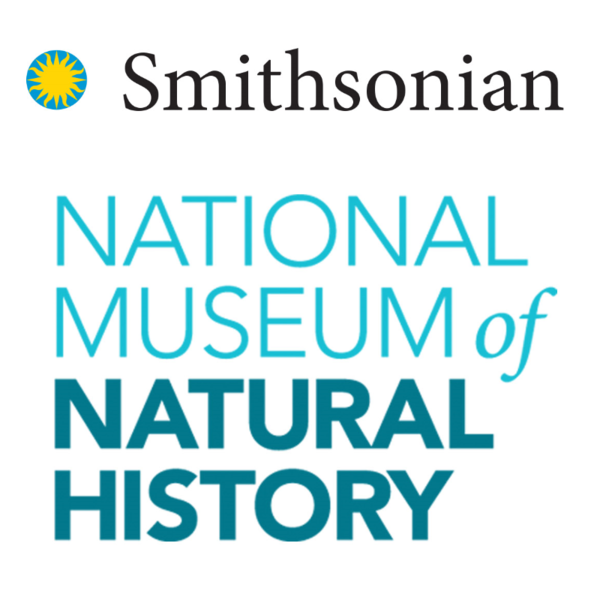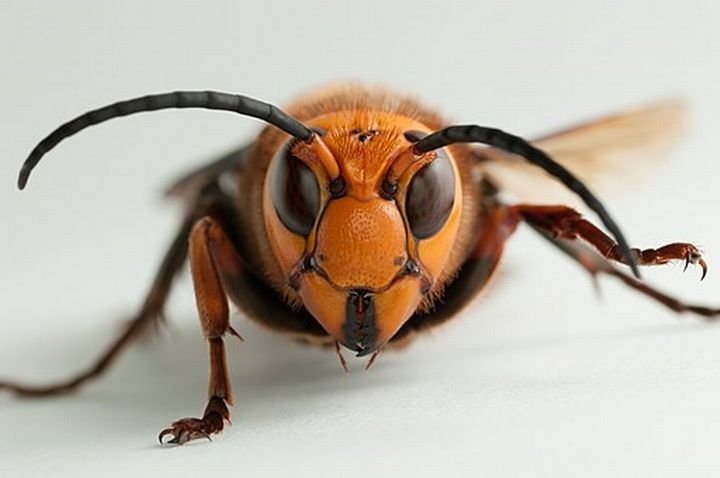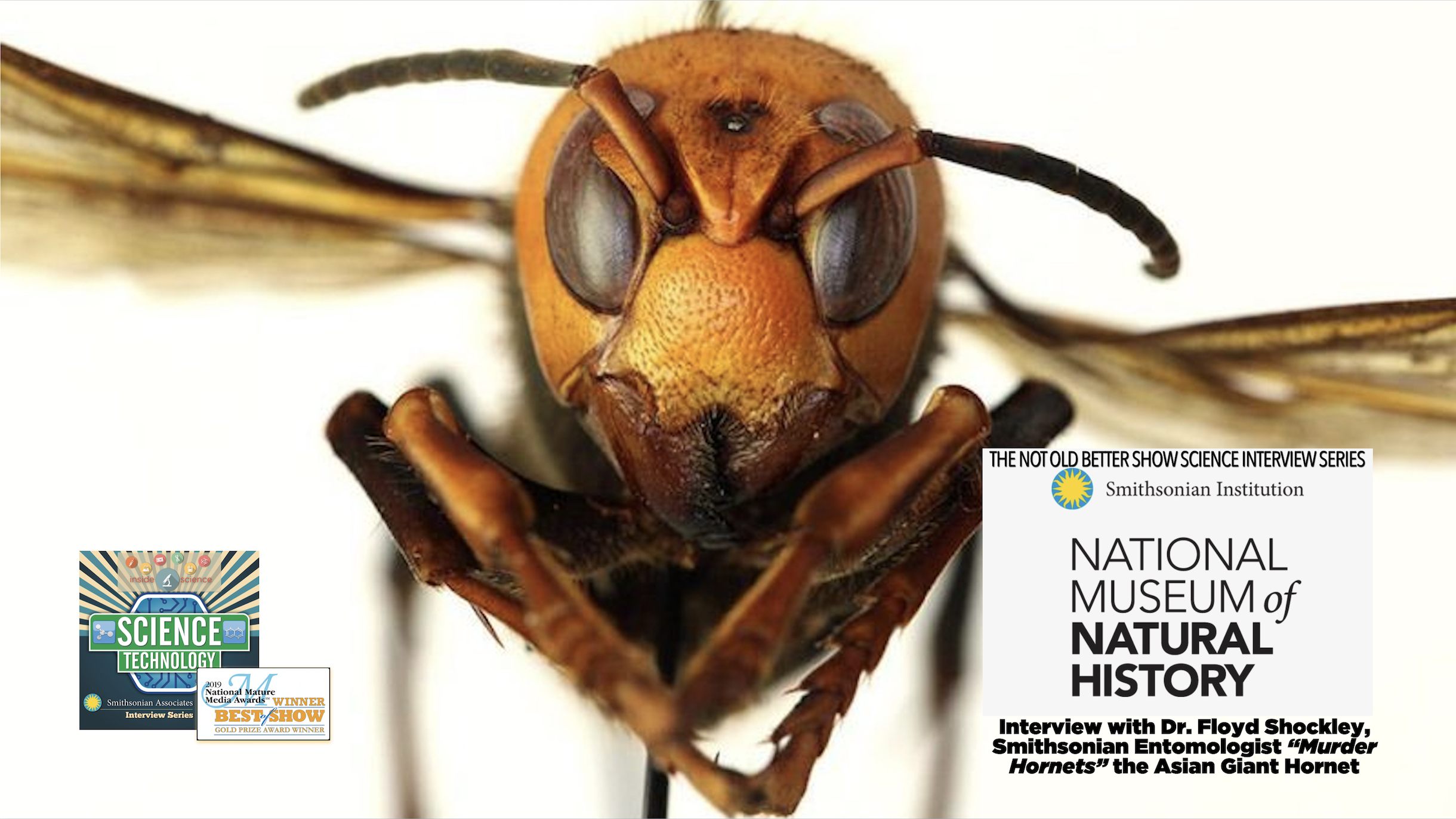Murder Hornets – Not What You Think…
Smithsonian Inside Science Interview with Dr. Floyd Shockley
Welcome to The Not Old Better Show. I’m Paul Vogelzang, and this is episode #449.
As part of our Smithsonian, Inside Science interview series, we have the latest buzz…Giant 2-inch insects known as “murder hornets” have arrived in the U.S. from Asia for the first time. They got their name because of the potential threat they pose to bees, and now there’s a rush to stop them before they multiply. “Bee lives matter.”

Asian giant hornet attacks and destroys honeybee hives. A few hornets can destroy a hive in a matter of hours. The hornets enter a “slaughter phase” where they kill bees by decapitating them. They then defend the hive as their own, taking the brood to feed their own young. They also attack other insects but are not known to destroy entire populations of those insects.
While they do not generally attack people or pets, they can attack when threatened. Their stinger is longer than that of a honeybee and their venom is more toxic. They can also sting repeatedly.

If it becomes established, this hornet will have negative impacts on the environment, economy, and public health of the United States.
Here to help us understand these hornets is Smithsonian’s, Dr. Floyd Shockley. Dr. Floyd Shockley is the Collections Manager for the Department of Entomology at Smithsonian’s National Museum of Natural History. According to Dr. Shockley, “More people die of honey bee stings in the U.S. than die annually, globally, from these hornets.” About 60 to 80 people die from allergic reactions to honey bee stings; only about 40 people die per year in Asia. mostly in Japan, from reactions to the giant hornet stings.
That said, the sting of the Asian giant hornet is far more painful and toxic than that of a honey bee. Researchers have likened the sensation to having a hot nail driven into one’s flesh. However, Shockley says giant hornets are only dangerous if provoked and tend to keep to themselves unless threatened, but they’re not a new thing…
That, of course, is our guest today, Dr. Floyd Shockley, and now please join me, via internet phone, in welcoming to The Not Old Better Show, Dr. Floyd Shockley.
My thanks to Dr. Floyd Shockley, from the Smithsonian National Museum of Natural History. My thanks, as always, to the Smithsonian team for all they do to support the show. And my thanks always to you, my wonderful Not Old Better Show audience. Remember, stay safe everyone, practice smart social distancing, and Talk About Better. The Not Old Better Show. Thanks, everybody. https://notold-better.com
NATIONAL GEOGRAPHIC VIDEO
Watch this short video from National Geographic for a quick overview of Asian giant hornet.
Paul Vogelzang (00:02):
Welcome to The Not Old Better Show, I’m Paul Vogelzang, and this is episode number 449. As part of our Smithsonian, it’s Side Science interview series, we have the latest buzz, giant two inch insects known as murder hornets have arrived in the United States from Asia for the first time. They got their name because of the potential threat they pose to bees. And now there’s a rush to stop them before they multiply, because bee lives matter. Asian giant hornets attack and destroy honeybee hives. A few hornets can destroy a hive. In a matter of hours, the hornets enter a slaughter phase where they kill bees by decapitating them. They then defend the hive as their own, taking the brood to feed their own young. They also attack other insects, but are not known to destroy entire populations of those insects. While they do not generally attack people or pets, they can attack when threatened, their stinger is longer than that of a honeybee, and their venom is much more toxic.
Paul Vogelzang (01:11):
They can also sting repeatedly. If the murder hornets become established, this hornet will have negative impacts on the environment, economy, and public health of the United States. Here to help us understand these hornets is Smithsonian’s Dr. Floyd Shockley. Dr. Floyd Shockley is the collections manager for the Department of Entomology at Smithsonian’s National Museum of Natural History. According to Dr. Shockley, more people die of honeybee stings in the United States then die annually globally, from these hornets. About 60 to 80 people die from allergic reactions to honeybee stings in the United States. Only about 40 people die per year in Asia, and mostly in Japan, from reactions to the stings from these giant Asian hornets. All that said the sting of an Asian giant hornet is far more painful and toxic than that of a honeybee. Researchers have likened this sensation to having a hot nail driven into one’s flesh. However, Dr. Shockley says giant hornets are only dangerous if provoked and tend to keep to themselves unless threatened, but they’re not necessarily a new thing.
Dr. Floyd Shockley (02:20):
It is a little confusing about sort of why all the sudden excitement because it’s not really a new thing, but anything we can do to calm people’s fears, focus on the facts and the evidence, and move away from sort of the sensationalist nature is time well spent. And I’ll be honest with you. I’m not probably going to be using the M word.
Paul Vogelzang (02:51):
That of course is our guest today, Dr. Floyd Shockley. And now please join me via internet phone in welcoming to The Not Old Better Show, Dr. Floyd Shockley. Dr. Floyd Shockley, welcome to the program.
Dr. Floyd Shockley (03:02):
Thanks for having me.
Paul Vogelzang (03:03):
It’s good to talk to you. I think we’re going to have a great conversation. Something that is getting an awful lot of attention these days, over the past couple of weeks. I know you’re very busy personally, with the subject. We’re going to talk about what I’ll refer to in a very nonscientific way, right at the top of the show, I’ll refer to these as the murder hornets, because that’s the word that’s getting tossed around into the media. The better name maybe is the Asian giant hornet, but tell us about these.
Dr. Floyd Shockley (03:28):
Well, thanks for asking. And I’m glad I’m getting an opportunity to dispel this right at the top of the interview. Murder hornets, I should point out, is not a common name that has ever been applied really prior to the publication of The New York Times, which sort of grabbed headlines a couple of weeks ago. Everyone else refers to these as Asian giant hornets or by their scientific name, Vespa mandarinia. These guys are of course, quite large, hence the giant part of the common name. Their social hornets, just like some of the hornets that people here in the US, they’re more commonly familiar with. The European hornet is one that is often mistaken for these, it’s established in much of the Eastern United States. It’s also rather large, but not nearly as large as these guys. It’s also an introduced species. It got here in the mid 19th century, and it’s firmly here now.
Dr. Floyd Shockley (04:41):
But what makes the best Vespa mandarinia or the giant Asian hornets of such interest to people right now is their large size. These guys are between one and a half and two inches long. That’s a pretty large for most wasps, and that’s the largest of the true hornets. Of course, not everything that’s a wasp is a hornet. Only those that belong in the genus Vespa are true hornets, and these guys are the biggest. They’re mainly not a problem for people. Usually, the only time that there is a major encounter with these guys in humans is, if you step into the nest, their nests are underground. They’re not hanging in trees like some of the other hornets that people are probably more familiar with. They take over basically, old burrows, rodent burrows and things, and build their nest in underground.
Dr. Floyd Shockley (05:47):
And so if you step down into them or disturb them, then of course, they’ll defend the hive. And of course the stings, there for a long time there was a mythology around these guys that the venom of the sting would melt flesh, and all types of terrible things, that they could shoot these droplets of venom up to a foot. None of that is true. These guys, just like most hornets, they have to make contact with whatever they’re stinging. Now, the stinger itself is pretty substantial. It’s almost half a centimeter long. You’re getting a pretty good needle. These stingers are not barbed like a honeybee. When a honeybee stings you, the stinger stays and it actually rips part of the abdomen out, and the bee ends up dying. With these guys, they don’t have those barbs so theoretically, they can sting you over and over again, as most other wasps can.
Dr. Floyd Shockley (06:53):
The venom is quite toxic, not lethal in many cases. The only time that you end up with a fatality is usually the same as with honeybees, it’s an allergic reaction to the venom. Not because the venom itself has a lethal load in it when it’s delivered. Also usually, the sting of a single wasp is not enough to cause death. Usually, you’re attacked by a swarm of them. And anything over 10 stings usually requires hospital intervention, and anything over 30 is usually considered emergency.
Paul Vogelzang (07:46):
Well, thank you for all of that. Dr. Shockley. These guys really do get some bad press and much of the press has really been around, they’re wiping out the very important species of honeybees. And honeybees seem to be very threatened right now with some other issues of climate change and so forth. And we need honey bees in our food ecosystem. So what is it about the honeybees that the hornets are so vicious about? Once they get into the hive, it’s almost a gruesome attack.
Dr. Floyd Shockley (08:18):
Most of the time giant Asian hornets are predators, but to be quite frank, honeybees are a little on the small side for their prey items, just because of the vast difference in size. A honeybee is only about half an inch to three quarters of an inch, and so it’s not really a very tasty meal. So when these guys attack honeybees, they’re not actually looking to eat the workers, they’re there for the honey supplies. They’re trying to raid the hive. And as the bees defend the honey and the hive, the hornets basically cut their heads off as quickly as they can. They have really powerful jaws and they just leave the dead bodies there. They don’t usually consume any of the honeybees. It doesn’t take a very large swarm to wipe out an entire honeybee colony, a couple of hours of work and they can wipe out a hive.
Dr. Floyd Shockley (09:25):
And so that part is true. They are really, really bad for honeybees, especially at a time when honeybees are already facing many other challenges. And part of that, if you don’t mind me saying, is because of the honeybees are non-native as well. The European honeybee is the one that we use commonly for agriculture and apiculture here in North America, but that’s an introduced species. We brought it here in the late 1600s. And part of that is because they have very low fidelity to particular host plants, meaning that they’ll pollinate almost anything, which makes them really useful in modern agriculture, because we cultivate a lot of plant species that also aren’t native to North America. That’s one of the things that makes them so useful. But I just wanted to put that out there that we do have other species of bees, native bees, but those don’t typically produce honey, and so they don’t quite get as much press. But yeah, the honeybees, honeybee and apiculture is incredibly valuable, it’s got some serious economics tied to it. And so many beekeepers are really closely watching what’s happening up in the Pacific Northwest.
Paul Vogelzang (10:59):
We are with Dr. Floyd Shockley. Dr. Floyd Shockley is the collections manager for the Department of Entomology at Smithsonian’s National Museum of Natural History. Dr. Shockley is with us today, we’re talking about the Asian giant hornet. And I wonder Dr. Shockley, if you’d tell us, can these hornets be managed and what’s the life cycle of these hornets?
Dr. Floyd Shockley (11:22):
They actually can be managed. I should point out though that, all of the evidence suggests that they are not established here. And even if you read the article in The New York Times, and subsequent articles published on it, most of the entomologists like myself, have been very clear that some were found, they were all destroyed, and we’re not seeing any evidence of them yet this year. There’s not been a single one found in 2020. And so while we are carefully monitoring the situation, there’s no evidence that any survived the winter, that they’re still in North America, and they certainly haven’t spread outside of the Pacific Northwest. So the stage that is usually the target of management programs, where these guys do exist are the queens. The queens are the only ones who can lay eggs, they’re the only ones that establish new nests.
Dr. Floyd Shockley (12:34):
And so those are the ones that fly in spring. They, overwinter usually under bark, in the ground. They do not make their nest where they’ve overwintered. And so most of them would be flying around right now, looking for appropriate nest sites to set up, feeding occasionally. Once she gets the nest set up and they reach a critical mass of about 50 workers, she’ll stop foraging all together, and they’ll do all of that. So she won’t leave the nest again until the end of the season and she’ll die, and they’ll make new ones to disperse at the end of the year. So there’s two cycles when queens are active. That’s first in the spring, when the ones who have overwintered are looking to establish new nests, during the summer is when the workers are out foraging.
Dr. Floyd Shockley (13:33):
And again, mostly they’re foraging for other insects, prey items that they can feed to their brood. And then at the end of the season, reproductives, males and females are both made. And then those females will fly off to find a new place to overwinter, so that they can start the cycle all over again, the following year.
Paul Vogelzang (14:00):
Mm-hmm (affirmative). So we’re talking spring, summer, winter, maybe about a year. And that’s the critical point in time that we need to be aware of this?
Dr. Floyd Shockley (14:09):
That’s correct, yeah. Queens live about a year, but everyone else lives about 10 to 15 weeks, and then they’re done.
Paul Vogelzang (14:19):
Fascinating stuff. We really appreciate your time today, Dr. Floyd Shockley. I just have one final question because I think this is certainly getting out there, and we appreciate all of the scientific information that you’re sharing with us. What should the public do at this point?
Dr. Floyd Shockley (14:33):
Well, I think especially, if you are not in the Pacific Northwest, you’re not going to really see any of these, but what you might see are other wasps and hornets. And there’s a tendency to overreact and kill those. And that’s ecologically very bad. A lot of those wasps and hornets are going to be doing a very important ecological service. A lot of them are out there collecting pest species that feed on crops, both in commercial growing farms, as well as private gardens. And so you don’t want to kill a whole bunch of wasps for no good reason. If you are in the Pacific Northwest, of course, we are actively asking for the public to be vigilant, especially those folks who own beehives, whether they’re professional apiculturists, or just to have hobby hives, and reach out and contact the Washington State Department of Agriculture.
Dr. Floyd Shockley (15:45):
The USDA has a big monitoring program now, where they’re watching for this. They put a lot of money in there to 2020 budget to monitor the program. Reach out to a professional, and in many cases, people can take a decent picture with their cell phone, and send that into the Department of Agriculture or to an entomologist that maybe they know personally. There’s a lot of us here in North America. A good cell phone picture is usually enough for us to do a quick idea of, yes, it is, no it isn’t, or maybe it’s something you should try and catch, or notify local authorities about. So we’re asking people to just be vigilant, we don’t think that they’re here, but we can’t rule out the possibility. And we need the public’s health because we can only be in so many places at a time.
Paul Vogelzang (16:42):
So helpful. Thank you so much, Dr. Floyd Shockley, for your time today for your generous time. Of course, we’ve been with Dr. Floyd Shockley from the Smithsonian National Museum of Natural History. We’ll put up links to where you can find out more information about Dr. Shockley and his work, as well as links to a couple of the sites that Dr. Shockley is mentioning, Washington Government site, USDA, and all of that. But Dr. Shockley, thanks so much for your time. We appreciate this solid information about these Asian giant hornets.
Dr. Floyd Shockley (17:11):
My pleasure, thanks for having me.
Paul Vogelzang (17:13):
My thanks to Dr. Floyd Shockley from the Smithsonian National Museum of Natural History. My thanks as always to the Smithsonian team for all they do to support the show, and my thanks as always to you, my wonderful, Not Old Better Show audience. Remember, stay safe everyone, practice smart, social distancing, and talk about better, The Not Old Better Show. Thanks everybody.


